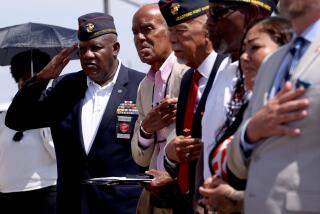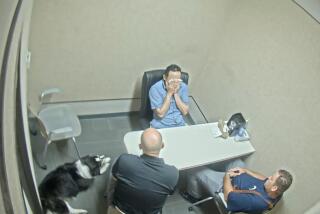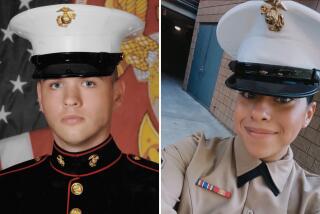Fate of Missing Brother Still Sears Laguna Man : Vietnam: George Patterson yearns for closure in the case of James Patterson, who was shot down in 1967 while on a combat mission.
LAGUNA BEACH â Inside the home of George and Judi Patterson are shelves of mementos the Orange County sheriffâs deputy and his wife have accumulated through the years. But none hold as much meaning--and hope--as the photos of George Pattersonâs brother, James Kelly Patterson, missing in action since 1967, when his A-6 Intruder was shot down over North Vietnam.
To the U.S. government, Lt. Cmdr. James Patterson is âpresumed killed in action, body not recovered.â To his brother, who visited Vietnam in May, learning more about what happened--and bringing Jamesâ remains home, if heâs really dead--is his great obsession.
âMy brother was a heck of a brother, he was a very special person,â Patterson said. âWhen he had his last R&R; he had a chance to go to Hawaii or Thailand or wherever, but he came to visit me in Da Nang.â
Their reunion wasnât spent guzzling beers. George Patterson, then a Marine Corps platoon leader, had pulled a three-day combat patrol duty. But his older brother dogged him to go along.
âSo, I issued him a helmet, flak jacket and an M-16 and took him with me on a patrol. Thatâs the kind of brother he was.â
A month later, Jamesâ A-6 Intruder was hit by a surface-to-air missile over North Vietnam. James, the bombardier-navigator, and the pilot parachuted to the ground. That was May 19, 1967. He was 26 years old.
For the next three days, James, who had a badly broken leg, communicated by radio with U.S. pilots searching for him. Although they tried to pluck him from enemy territory, he was captured by the North Vietnamese. On May 22, searchers were unable to regain contact.
The pilot, Eugene (Red) McDaniel, was captured and spent six years in POW camps until he was released and returned to the United States in 1973. As the director of the Virginia-based American Defense Institute, which is active in POW and MIA issues, McDaniel said he believes Jamesâ story is âthe most compellingâ among the 2,202 servicemen still unaccounted for in the Vietnam War.
What makes his case interesting, McDaniel and Patterson said, is that former POWs have stated James may have survived the leg injury and was taken from Vietnam to prison camp in the then-Soviet Union.
Patterson has found many discrepancies in North Vietnamâs story that his brother was shot to death and buried near the crash site. Also, an inspection of the purported grave site by U.S. military experts found nothing to indicate a body had ever been there.
âI donât believe heâs dead,â McDaniel said. âI believe he is very much alive.â
The family was informed by the military that James was presumed dead by April 16, 1974, joining the ranks of the âunaccounted for,â his brother said. But things changed in 1985 after the family gathered new information from various sources, including former POWs.
First, one ex-POW in recent years told Patterson he saw an interrogation questionnaire with his brotherâs name on it. Another former POW reported seeing Jamesâ name on a cell wall in an North Vietnamese prison near the Chinese border. Both stories jibed with McDanielâs, who was told by a prison guard in 1967 that James had recovered from his injury and was well.
A Moscow newspaper wrote of a second U.S. pilot shot down over North Vietnam on May 19, 1967, who was taken over land through China to Saryshagansk, in the then-Soviet Republic of Kazakhstan.
Many questions persist about Pattersonâs brother, despite President Clintonâs decision to normalize relations with Hanoi three weeks ago, said Mary Dzaugis, a spokeswoman for the Washington-based National League of Families of American Prisoners and Missing in Southeast Asia.
âThere were men known to be alive and our question is where are they today?â Dzaugis said. âThey should be easily accounted for if they are dead, or should be returned alive. The league supports the return of all live prisoners, repatriation of all recoverable remains.â
More than 28 years have gone by, but George Patterson, as so many other relatives of MIAs, seeks closure to help heal an emotional wound.
âThe government, at the very least, should help us put a closure to this,â Patterson said. âIf you gloss over these governmental reports, you say, âGood grief. This doesnât jibe with whatâs been going on.â â
In his home, Patterson, 51, has at least five, 3-inch-thick folders filled with correspondence, reports and news clippings on his brother. Through the years, he has had ongoing communications with state legislators, H. Ross Perot, U.S. senators, POWs, MIA groups and their families, âeveryone who could help,â he said.
The standing joke in the family, said his wife, Judi, is that when company is over, âthere goes George, talking about Jamesâ case. But if it starts to bother you, just raise your hand and heâll give you a break.â
âYou have to understand that these two brothers were very close to each other,â she said.
The brothers were born in Long Beach four years apart. Their father was a career Navy man who took his small family to Belgium and then Panama before returning to the United States. After settling in South Pasadena, James graduated from high school and then went into the Naval Academy in 1963.
âMy folks made me tag along with him. He was four years older so I would crimp his style, but he was always close to me and was always protective,â Patterson said.
With the help of McDaniel, Patterson has acquired an aerial photograph taken from an F-4 fighter jet that captured his brotherâs plane going down over North Vietnam. Patterson hired a high-tech firm to examine the photo and with the help of satellite imaging, plot the crash site and a likely location of where his brother and McDaniel came down.
On his recent trip to Vietnam, Patterson hired an interpreter and went into the Hoa Binh province. He spoke with Bui Van Bon, a witness whose sighting has been reported to the Joint Task Force on Full Accounting, the official U.S. body looking into missing servicemen. Bon told him that he had heard that one pilot was captured, one killed by the militia.
A week later, he went back with a representative from the French Embassy and two interpreters. He talked with villagers who countered Hanoiâs statement that his brother was found near a remote ridgeline rather than in a valley surrounded by hamlets.
âMy best explanation is that [James] didnât die but survived his capture,â Patterson said. But if his brother is dead, Patterson has only one fervent desire: that his brotherâs remains be found and brought home.
âOf all the people in the world,â Patterson said, âhe is the one I would like to emulate. He was the cream of the cream.â
More to Read
Sign up for Essential California
The most important California stories and recommendations in your inbox every morning.
You may occasionally receive promotional content from the Los Angeles Times.










